Multi-domain computing research: in the coming first year of cross-domain fusion, major suppliers will quicken their pace of launching new solutions.
As vehicle intelligence develops, electrical/electronic architecture begins to evolve from domain control centralized architecture to multi-domain fusion computing/central computing architecture. In this development trend, OEMs, Tier 1 suppliers and chip companies enjoy new market opportunities.
 In July 2023, SAIC unveiled a vehicle motion controller (VMC) for central coordination. Based on vehicle central fusion motion control, it enables a shorter cross-domain control link for vehicles, and allows for more efficient control over the body and chassis in the state of human driving or intelligent driving.
In July 2023, SAIC unveiled a vehicle motion controller (VMC) for central coordination. Based on vehicle central fusion motion control, it enables a shorter cross-domain control link for vehicles, and allows for more efficient control over the body and chassis in the state of human driving or intelligent driving.
 In July 2023, BYD first introduced "Eyes of the God", its advanced intelligent driving assistance system that adopts the central computing platform + zonal domain controller deep collaboration system architecture.
In July 2023, BYD first introduced "Eyes of the God", its advanced intelligent driving assistance system that adopts the central computing platform + zonal domain controller deep collaboration system architecture.
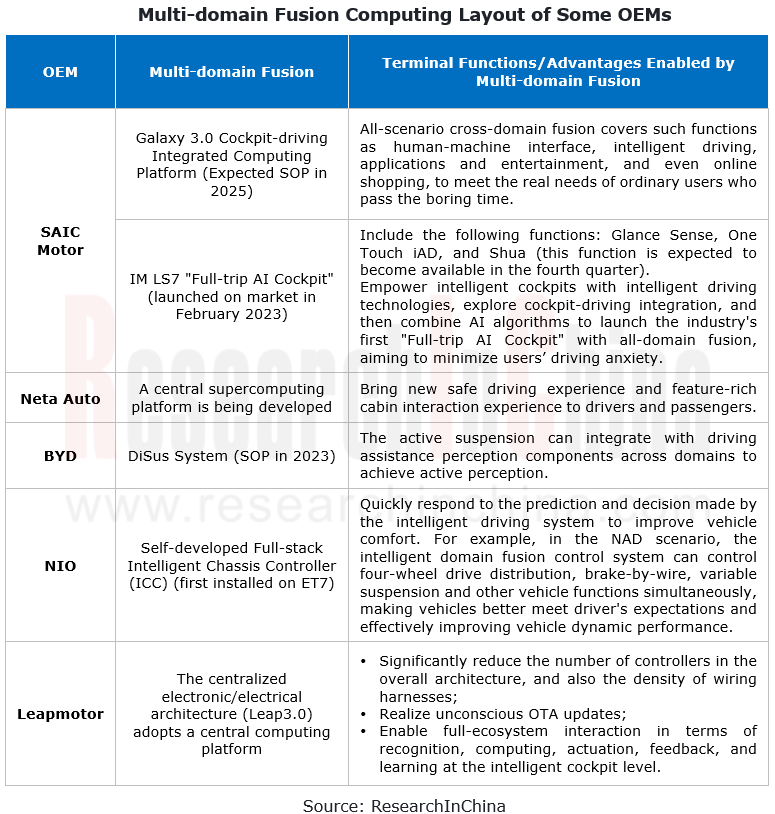
Major Tier 1 suppliers step into the multi-domain computing field by virtue of their own strengths.
From the perspective of layout, Tier 1 suppliers deploy multi-domain computing in a relatively flexible way. They rely on their own superiorities to lay out multi-domain fusion, for example, body and chassis, body and cockpit, and chassis and intelligent driving domains.
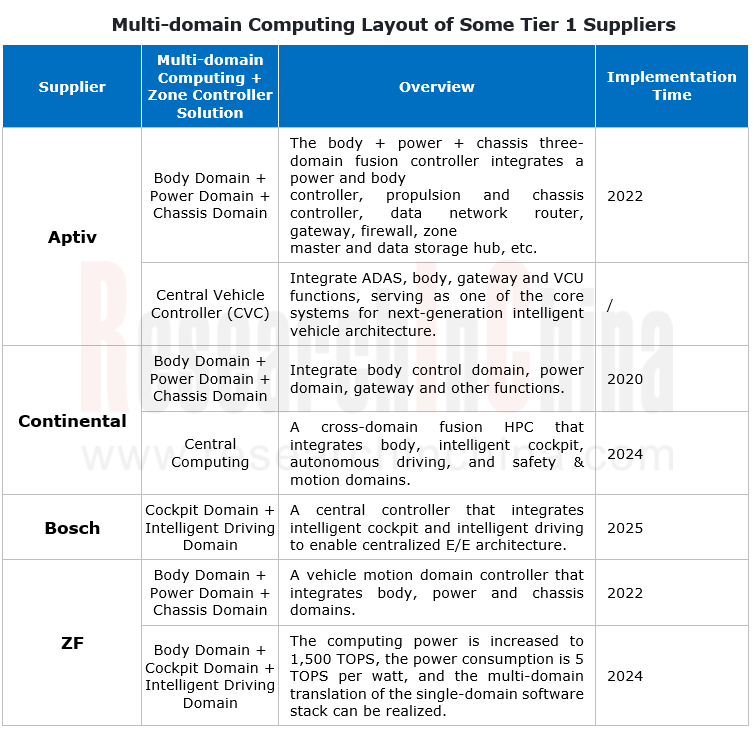
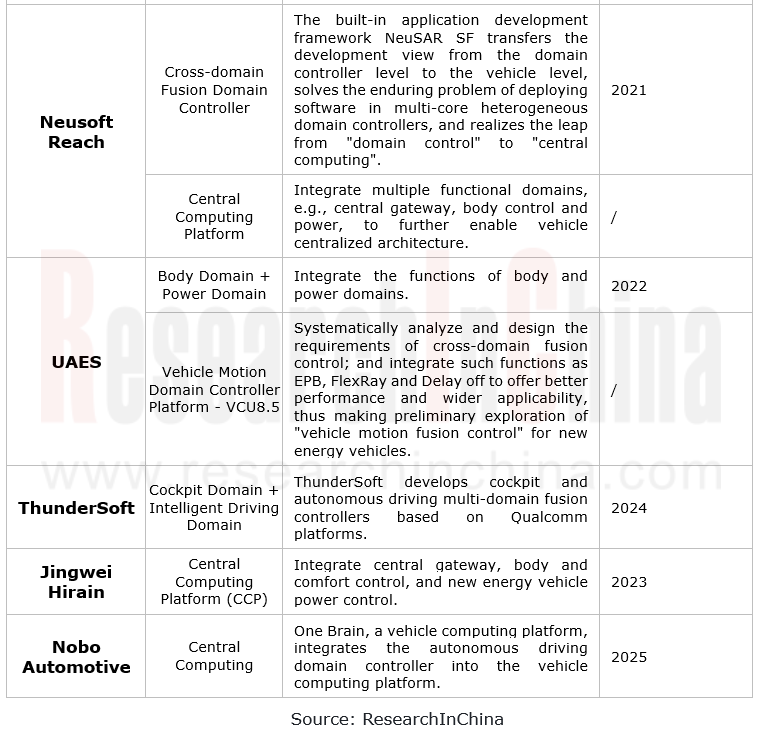
UAES
UAES has established the special cross-domain control division, and has signed strategic cooperation agreements with ecosystem partners like Horizon Robotics, Neusoft Reach, ABUP, LEADMOVE, and TE Connectivity.
In December 2022, UAES released its vehicle computing platform (VCP), which uses the new-generation NXP S32G SoC and integrates functions of power and body domains, including vehicle control, BCM and gateway. For some projects, driving assistance functions are integrated;
In May 2023, UAES launched VCU8.5, a vehicle motion domain controller platform which systematically analyzes and designs the requirements of cross-domain fusion control and integrates such functions as EPB, FlexRay and Delay off.
Continental
In April 2023, Continental exhibited its cross-domain vehicle control high performance computer (HPC) for the first time. In addition to the original body control and gateway functions, this product also integrates chassis control applications. At present, Continental has secured two local orders in China, and the model GAC Aion Hyper GT will become the first production car carrying the product. It is expected that in 2024, this HPC will be installed on more than 30 different models of several automakers.
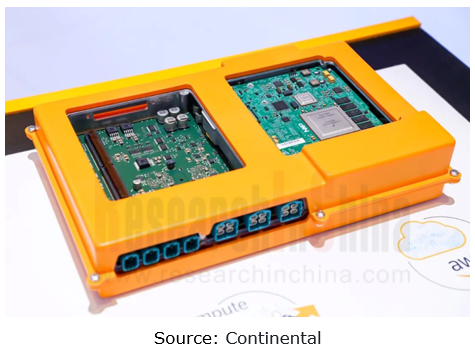
PATEO CONNECT+
In June 2023, PATEO CONNECT+ managed to develop its first vehicle central computing module (CCM). Based on the central gateway, this platform expands computing power, and integrates intelligent cockpit, ADAS, body and vehicle control functions.
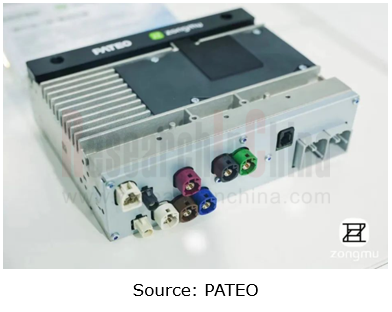
Key technical support for multi-domain computing: multi-domain computing SoC, and cross-domain fusion software platform.
At present, multi-domain fusion is seen mainly in two aspects: hardware and software. From a hardware integration perspective, multi-domain fusion features multi-SoC integration, that is, different domain controllers are integrated into one box composed of multiple SoCs or MCUs, and different functions are supported by different chips. The multi-domain fusion enabled by a single chip requires a SoC to complete different functions. There are now still some challenges in realizing single-SoC multi-domain fusion.
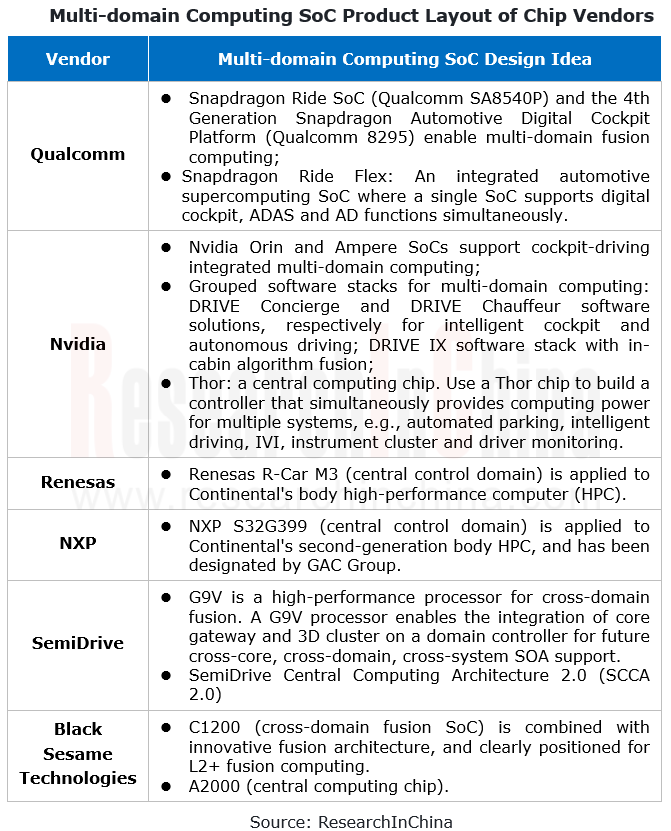
Black Sesame Technologies
In July 2023, Black Sesame Technologies announced C1200, the first product of the Wudang Series. As China’s first automotive cross-domain multifunctional fusion computing chip, C1200 meets the requirements of autonomous driving, intelligent cockpit, body control and other computing functions.
Wudang C1200 packs A78AE (performance up to 150KDMIPS), an automotive high-performance CPU core that supports lockstep, the automotive high-performance GPU core G78AE, a built-in mature high-performance Audio DSP module, and the self-developed new-generation NeuralIQ ISP module that processes 1.5G pixels per second online. Moreover, C1200 also has a built-in ASIL-D Safety Island, and a Security Module subject to the National Cryptography Level 2 and EVITA full, meeting the reliability requirements of the highest vehicle safety level.
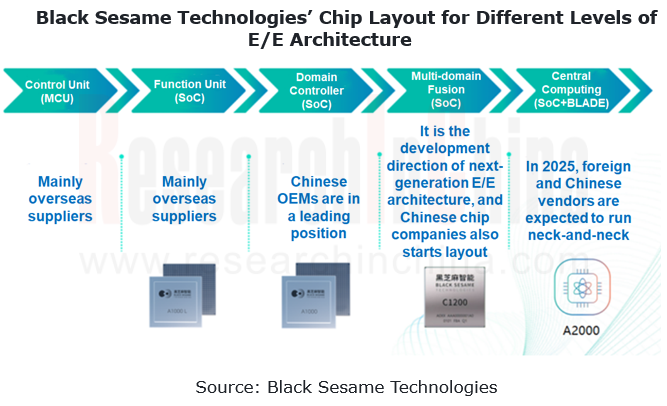
In addition to chips, the development of cross-domain fusion also needs to be supported by vehicle OS. In current stage, vehicle functional domains have yet to be fully integrated, and there is no intelligent vehicle operating system that can be applied directly for a long time in the world. This is an opportunity for Chinese vehicle OS providers to overtake on the bend.
Arraymo (ArcherMind Technology)
In April 2023, Arraymo, an arm of ArcherMind Technology, launched Fusion OS, a cross-domain fusion vehicle software computing platform which is mainly compatible with operating systems in different domains. Fusion OS quickly connects core functional domains such as intelligent cockpit, central control, and intelligent driving from the bottom layer for high integration of functional modules.
Intelligent Vehicle Multi-Domain Computing Industry Report, 2023 highlights the following:
 Multi-domain computing development ideas, including central domain controller, cockpit-driving integration, integration of cockpit and body domains, integration of chassis and intelligent driving domains, and central computing platform + zone controllers (development, main cases, etc.);
Multi-domain computing development ideas, including central domain controller, cockpit-driving integration, integration of cockpit and body domains, integration of chassis and intelligent driving domains, and central computing platform + zone controllers (development, main cases, etc.);
 Key technologies of multi-domain computing, including multi-domain fusion computing SoC, multi-domain computing software OS, multi-domain computing Ethernet, multi-domain computing gateway, and zone controller, (development trends, actual cases, etc.);
Key technologies of multi-domain computing, including multi-domain fusion computing SoC, multi-domain computing software OS, multi-domain computing Ethernet, multi-domain computing gateway, and zone controller, (development trends, actual cases, etc.);
 OEMs’ multi-domain fusion development planning, product R&D, technology layout, etc.;
OEMs’ multi-domain fusion development planning, product R&D, technology layout, etc.;
 Chinese and foreign Tier 1 suppliers’ products, technology layout, cooperation, etc. in multi-domain computing and zone controller.
Chinese and foreign Tier 1 suppliers’ products, technology layout, cooperation, etc. in multi-domain computing and zone controller.
Intelligent Vehicle Multi-Domain Computing Industry Report, 2024
Multi-Domain Computing Research: A Summary of Several Ideas and Product Strategies for Cross-Domain Integration
1. Several ideas and strategies for cross-domain integration of OEMs
With the increasi...
Analysis on Xiaomi Auto's Electrification, Connectivity, Intelligence and Sharing, 2024
Research on Xiaomi Auto: Xiaomi Auto's strengths and weaknesses
Since the release of SU7, Xiaomi delivered 7,058 units and 8,630 units in April and May, respectively, and more than 10,000 units in bo...
ADAS and Autonomous Driving Tier 1 Suppliers Research Report, 2024 - Foreign Companies
Research on foreign ADAS Tier 1 suppliers: make all-round attempts to transform and localize supply chain and teams.
1. Foreign ADAS Tier 1 suppliers fall behind relatively in deve...
Research Report on Passenger Car Cockpit Entertainment--In-vehicle Game, 2024
1. In-vehicle entertainment screens are gaining momentum, and Chinese brands rule the roost.
In-vehicle entertainment screens refers to display screens used for entertainment activities such as viewi...
Body (Zone) Domain Controller and Chip Industry Research Report,2024
Research on body (zone) domain controller: an edge tool to reduce vehicle costs, and enable hardware integration + software SOA.
Integration is the most important means to lower vehicle costs. Funct...
China Charging/Swapping (Liquid Cooling Overcharging System, Small Power, Swapping, V2G, etc) Research Report, 2024
Research on charging and swapping: OEMs quicken their pace of entering liquid cooling overcharging, V2G, and virtual power plants.
China leads the world in technological innovation breakthroughs in ...
Autonomous Driving SoC Research Report, 2024
Autonomous driving SoC research: for passenger cars in the price range of RMB100,000-200,000, a range of 50-100T high-compute SoCs will be mass-produced. According to ResearchInChina’s sta...
Automotive Cockpit Domain Controller Research Report, 2024
Research on cockpit domain controller: Facing x86 AI PC, multi-domain computing, and domestic substitution, how can cockpit domain control differentiate and compete?
X86 architecture VS ARM ar...
Chinese OEMs (Passenger Car) Going Overseas Report, 2024--Germany
Keywords of Chinese OEMs going to Germany: electric vehicles, cost performance, intelligence, ecological construction, localization
The European Union's temporary tariffs on electric vehicles in Chi...
Analysis on DJI Automotive’s Autonomous Driving Business, 2024
Research on DJI Automotive: lead the NOA market by virtue of unique technology route.
In 2016, DJI Automotive’s internal technicians installed a set of stereo sensors + vision fusion positioning syst...
BYD’s Layout in Electrification, Connectivity, Intelligence and Sharing and Strategy Analysis Report, 2023-2024
Insight: BYD deploys vehicle-mounted drones, and the autonomous driving charging robot market is expected to boom.
BYD and Dongfeng M-Hero make cross-border layout of drones.
In recent years,...
Great Wall Motor’s Layout in Electrification, Connectivity, Intelligence and Sharing and Strategy Analysis Report, 2023-2024
Great Wall Motor (GWM) benchmarks IT giants and accelerates “Process and Digital Transformation”.
In 2022, Great Wall Motor (GWM) hoped to use Haval H6's huge user base to achieve new energy transfo...
Cockpit AI Agent Research Report, 2024
Cockpit AI Agent: Autonomous scenario creation becomes the first step to personalize cockpits
In AI Foundation Models’ Impacts on Vehicle Intelligent Design and Development Research Report, 2024, Res...
Leading Chinese Intelligent Cockpit Tier 1 Supplier Research Report, 2024
Cockpit Tier1 Research: Comprehensively build a cockpit product matrix centered on users' hearing, speaking, seeing, writing and feeling.
ResearchInChina released Leading Chinese Intelligent Cockpit ...
Global and China Automotive Wireless Communication Module Market Report, 2024
Communication module and 5G research: 5G module installation rate reaches new high, 5G-A promotes vehicle application acceleration
5G automotive communication market has exploded, and 5G FWA is evolv...
ADAS and Autonomous Driving Tier 1 Suppliers Research Report, 2024 – Chinese Companies
ADAS Tier1s Research: Suppliers enter intense competition while exploring new businesses such as robotics
In China's intelligent driving market, L2 era is dominated by foreign suppliers. Entering era...
Automotive Gateway Industry Report, 2024
Automotive gateway research: 10BASE-T1S and CAN-XL will bring more flexible gateway deployment solutions
ResearchInChina released "Automotive Gateway Industry Report, 2024", analyzing and researching...
Global and China Electronic Rearview Mirror Industry Report, 2024
Research on electronic rearview mirrors: electronic internal rearview mirrors are growing rapidly, and electronic external rearview mirrors are facing growing pains
ResearchInChina released "Global a...